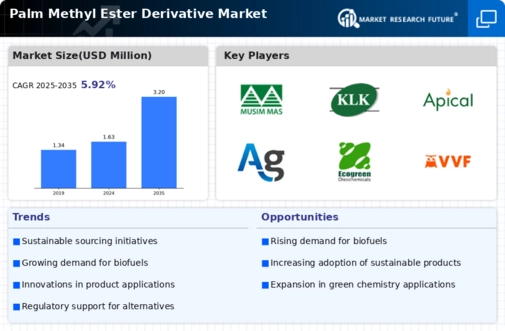-
Executive Summary
-
Scope of the Report
-
2.1
-
Market Definition
-
Scope of the Study
-
List of Assumptions
-
Markets Structure
-
Market Research Methodology
-
Research Process
-
Primary Research
-
Secondary Research
-
Market Size Estimation
-
Forecast Model
-
Market Factor Analysis
-
Supply Chain Analysis
- Raw Material Suppliers
- Manufacturers/Service Providers of
- Distributors/Retailers/Wholesalers/E-Commerce
- End Users
-
Palm Methyl Ester Derivative
-
Merchants
-
Porter’s Five Forces Model
- Intensity of Rivalry
- Threat of Substitutes
- Bargaining Power of Suppliers
- Bargaining Power of Buyers
-
4.2.1
-
Threat of New Entrants
-
Pricing Analysis
-
Market Dynamics of the Global Palm Methyl Ester Derivative
-
Market
-
Introduction
-
Drivers
-
Restraints
-
Opportunities
-
Challenges
-
Global Palm Methyl Ester Derivative Market, by Product
-
Type
-
Introduction
-
Methyl Caprylate
- Market Estimates
- Market Estimates & Forecast, by Region,
- Methyl Laurate
- Market Estimates & Forecast,
- Market Estimates & Forecast, by Region, 2019–2030
-
& Forecast, 2019–2030
-
Methyl Myristate
- Market Estimates & Forecast, 2019–2030
- Market Estimates & Forecast, by Region, 2019–2030
-
Methyl
- Market Estimates & Forecast, 2019–2030
-
Palmitate
-
6.4.2
-
Market Estimates & Forecast, by Region, 2019–2030
-
Methyl Stearate
- Market Estimates & Forecast, 2019–2030
- Market Estimates
-
& Forecast, by Region, 2019–2030
-
Methyl Oleate
- Market
- Market Estimates & Forecast,
-
Estimates & Forecast, 2019–2030
-
by Region, 2019–2030
-
Methyl Linoleate
- Market Estimates
- Market Estimates & Forecast, by Region,
-
& Forecast, 2019–2030
-
Global Palm Methyl Ester Derivative Market, by Application
-
Introduction
-
Soap and Detergent
- Market Estimates &
- Market Estimates & Forecast, by Region,
-
Forecast, 2019–2030
-
Personal Care and Cosmetics
- Market Estimates
- Market Estimates & Forecast, by Region,
-
& Forecast, 2019–2030
-
Lubricants and Additives
- Market Estimates &
- Market Estimates & Forecast, by Region,
-
Forecast, 2019–2030
-
Biofuel
- Market Estimates & Forecast, 2019–2030
- Market Estimates & Forecast, by Region, 2019–2030
-
Textile
- Market Estimates & Forecast, 2019–2030
-
Treatment
-
7.6.2
-
Market Estimates & Forecast, by Region, 2019–2030
-
Agriculture
- Market Estimates & Forecast, 2019–2030
- Market Estimates
-
& Forecast, by Region, 2019–2030
-
Others
- Market Estimates
- Market Estimates & Forecast, by Region,
-
& Forecast, 2019–2030
-
Global Palm Methyl Ester Derivative Market, by Region
-
Introduction
-
North America
- Market Estimates & Forecast,
- Market Estimates & Forecast, by Product Type, 2019–2030
- Market Estimates & Forecast, by Application, 2019–2030
- Canada
-
8.2.4
-
US
-
Estimates & Forecast, by Product Type, 2019–2030
-
& Forecast, by Application, 2019–2030
-
Estimates & Forecast, 2019–2030
-
by Product Type, 2019–2030
-
Application, 2019–2030
-
Europe
- Market Estimates & Forecast,
- Market Estimates & Forecast, by Product Type, 2019–2030
- Market Estimates & Forecast, by Application, 2019–2030
-
8.3.4
-
Germany
-
8.3.4.2
-
Market Estimates & Forecast, by Product Type, 2019–2030
-
Estimates & Forecast, by Application, 2019–2030
-
8.3.5.1
-
Market Estimates & Forecast, 2019–2030
-
Forecast, by Product Type, 2019–2030
-
by Application, 2019–2030
-
Forecast, 2019–2030
-
Type, 2019–2030
-
8.3.7.3
-
Market
-
France
-
Market Estimates &
-
Market Estimates & Forecast,
-
Italy
-
Market Estimates &
-
Market Estimates & Forecast, by Product
-
Market Estimates & Forecast, by Application,
-
Spain
-
Market Estimates & Forecast, 2019–2030
-
Market Estimates & Forecast, by Product Type, 2019–2030
-
Market Estimates & Forecast, by Application, 2019–2030
-
& Forecast, by Product Type, 2019–2030
-
Forecast, by Application, 2019–2030
-
Estimates & Forecast, 2019–2030
-
by Product Type, 2019–2030
-
Application, 2019–2030
-
& Forecast, 2019–2030
-
Product Type, 2019–2030
-
Application, 2019–2030
-
& Forecast, 2019–2030
-
Product Type, 2019–2030
-
8.4.2.3
-
UK
-
Market Estimates & Forecast, 2019–2030
-
Market Estimates
-
Market Estimates &
-
Russia
-
Market
-
Market Estimates & Forecast,
-
Market Estimates & Forecast, by
-
Rest of Europe
-
Market Estimates
-
Market Estimates & Forecast, by
-
Market Estimates & Forecast, by
-
Asia-Pacific
-
Market Estimates
-
Market Estimates & Forecast, by
-
Market Estimates & Forecast, by Application,
-
China
-
Market Estimates & Forecast, 2019–2030
-
Market Estimates & Forecast, by Product Type, 2019–2030
-
Market Estimates & Forecast, by Application, 2019–2030
-
& Forecast, by Product Type, 2019–2030
-
Forecast, by Application, 2019–2030
-
Estimates & Forecast, 2019–2030
-
by Product Type, 2019–2030
-
Application, 2019–2030
-
& Forecast, 2019–2030
-
Product Type, 2019–2030
-
& Forecast, 2019–2030
-
Product Type, 2019–2030
-
Forecast, 2019–2030
-
Type, 2019–2030
-
& Forecast, 2019–2030
-
Product Type, 2019–2030
-
8.5.3
-
GCC Countries
-
8.5.3.2
-
India
-
Market Estimates & Forecast, 2019–2030
-
Market Estimates
-
Market Estimates &
-
South Korea
-
Market
-
Market Estimates & Forecast,
-
Market Estimates & Forecast, by
-
Indonesia
-
Market Estimates
-
Market Estimates & Forecast, by
-
Market Estimates & Forecast, by Application,
-
Australia & New Zealand
-
Market Estimates
-
Market Estimates & Forecast, by
-
Market Estimates & Forecast, by Application,
-
Rest of Asia-Pacific
-
Market Estimates &
-
Market Estimates & Forecast, by Product
-
Market Estimates & Forecast, by Application,
-
Middle East & Africa
-
Market Estimates
-
Market Estimates & Forecast, by
-
Market Estimates & Forecast, by Application,
-
Turkey
-
Market Estimates & Forecast,
-
Market Estimates & Forecast, by Product Type, 2019–2030
-
Market Estimates & Forecast, by Application, 2019–2030
-
Market Estimates & Forecast, 2019–2030
-
Market Estimates & Forecast, by Product Type, 2019–2030
-
Estimates & Forecast, by Application, 2019–2030
-
Estimates & Forecast, by Product Type, 2019–2030
-
& Forecast, by Application, 2019–2030
-
& Africa
-
8.5.5.2
-
Market
-
South Africa
-
Market Estimates & Forecast, 2019–2030
-
Market
-
Market Estimates
-
Rest of the Middle East
-
Market Estimates & Forecast, 2019–2030
-
Market Estimates & Forecast, by Product Type, 2019–2030
-
Estimates & Forecast, by Application, 2019–2030
-
& Forecast, by Product Type, 2019–2030
-
Forecast, by Application, 2019–2030
-
Estimates & Forecast, 2019–2030
-
by Product Type, 2019–2030
-
Application, 2019–2030
-
& Forecast, 2019–2030
-
Product Type, 2019–2030
-
8.6.5
-
Rest of Latin America
-
8.6.5.3
-
Market
-
Latin America
-
Market Estimates & Forecast, 2019–2030
-
Market Estimates
-
Market Estimates &
-
Brazil
-
Market
-
Market Estimates & Forecast,
-
Market Estimates & Forecast, by
-
Argentina
-
Market Estimates
-
Market Estimates & Forecast, by
-
Market Estimates & Forecast, by Application,
-
Mexico
-
Market Estimates & Forecast,
-
Market Estimates & Forecast, by Product Type, 2019–2030
-
Market Estimates & Forecast, by Application, 2019–2030
-
Market Estimates & Forecast, 2019–2030
-
Market Estimates & Forecast, by Product Type, 2019–2030
-
Market Estimates & Forecast, by Application, 2019–2030
-
Competitive
-
Landscape
-
Introduction
-
Market Key Strategies
-
Competitive
-
Benchmarking
-
Key Development Analysis (Expansions/Mergers & Acquisitions/Joint
-
Ventures/New Palm Methyl Ester Derivative Developments/Agreements/Investments)
-
Company Profiles
-
Musim Mas
- Company Overview
- Products Offered
- Key Developments
- SWOT Analysis
- Key Strategies
-
10.1.2
-
Financial Overview
-
KLK Oleo
-
Emery
-
Oleochemicals Group
-
Carotino Group
-
Apical Group
-
Asian
-
Agri
-
Ecogreen Oleochemicals
-
Oleon NV
-
VVF LLC
-
10.10
-
Kao Corporation Inc.
-
Appendix
-
-
LIST OF TABLES
-
Table
-
1: Global Palm Methyl Ester Derivative Market, by region, 2019–2030
-
Table
-
2: North America: Palm Methyl Ester Derivative Market, by Country, 2019–2030
-
Table 3: Europe: Palm Methyl Ester Derivative Market, by Country, 2019–2030
-
Table 4: Asia-Pacific: Palm Methyl Ester Derivative Market, by Country, 2019–2030
-
Table 5: Middle East & Africa: Palm Methyl Ester Derivative Market, by Country,
-
Table 6: Latin America: Palm Methyl Ester Derivative Market,
-
by Country, 2019–2030
-
Table 13: Global Palm Methyl Ester Derivative Product
-
Type Market, by Region, 2019–2030
-
Table 14: North America: Palm Methyl
-
Ester Derivative Product Type Market, by Country, 2019–2030
-
Table 15:
-
Europe: Palm Methyl Ester Derivative Product Type Market, by Country, 2019–2030
-
Table 16: Asia-Pacific: Palm Methyl Ester Derivative Product Type Market, by Country,
-
Table 17: Middle East & Africa: Palm Methyl Ester Derivative
-
Product Type Market, by Country, 2019–2030
-
Table 18: Latin America: Palm
-
Methyl Ester Derivative Product Type Market, by Country, 2019–2030
-
Table
-
19: Global Palm Methyl Ester Derivative Product Type Market, by Region, 2019–2030
-
Table 20: North America: Palm Methyl Ester Derivative Product Type Market, by
-
Country, 2019–2030
-
Table 21: Europe: Palm Methyl Ester Derivative Product
-
Type Market, by Country, 2019–2030
-
Table 22: Asia-Pacific: Palm Methyl
-
Ester Derivative Product Type Market, by Country, 2019–2030
-
Table 23:
-
Middle East & Africa: Palm Methyl Ester Derivative Product Type Market, by Country,
-
Table 24: Latin America: Palm Methyl Ester Derivative Product
-
Type Market, by Country, 2019–2030
-
Table 25: Global Palm Methyl Ester
-
Derivative Product Type Market, by Region, 2019–2030
-
Table 26: Global
-
Palm Methyl Ester Derivative Product Type Market, by Region, 2019–2030
-
Table 27: North America: Palm Methyl Ester Derivative Market, by Country, 2019–2030
-
Table 29: North America: Palm Methyl Ester Derivative Market, by Product Type,
-
Table 30: North America: Palm Methyl Ester Derivative Market,
-
by Application, 2019–2030
-
Table 31: Europe: Palm Methyl Ester Derivative
-
Market, by Country, 2019–2030
-
Table 32: Europe: Palm Methyl Ester Derivative
-
Market, by Product Type, 2019–2030
-
Table 33: Europe: Palm Methyl Ester
-
Derivative Market, by Application, 2019–2030
-
Table 34: Asia-Pacific:
-
Palm Methyl Ester Derivative Market, by Country, 2019–2030
-
Table 35:
-
Asia-Pacific: Palm Methyl Ester Derivative Market, by Product Type, 2019–2030
-
Table 36: Asia-Pacific: Palm Methyl Ester Derivative Market, by Application, 2019–2030
-
Table 37: Middle East & Africa: Palm Methyl Ester Derivative Market, by Country,
-
Table 38: Middle East & Africa: Palm Methyl Ester Derivative
-
Market, by Product Type, 2019–2030
-
Table 39: Middle East & Africa:
-
Palm Methyl Ester Derivative Market, by Application, 2019–2030
-
Table
-
40: Latin America: Palm Methyl Ester Derivative Market, by Country, 2019–2030
-
Table 41: Latin America: Palm Methyl Ester Derivative Market, by Product Type,
-
Table 42: Latin America: Palm Methyl Ester Derivative Market,
-
by Application, 2019–2030
-
LIST OF FIGURES
-
FIGURE
-
1-- Global Palm Methyl Ester Derivative Market Segmentation
-
FIGURE 2-- Forecast
-
Research Methodology
-
-- Porter’s Five Forces Analysis of the
-
Global Palm Methyl Ester Derivative Market
-
FIGURE 4-- Value Chain/Supply Chain
-
of Global Palm Methyl Ester Derivative Market
-
FIGURE 5-- Share of Global Palm
-
Methyl Ester Derivative Market, by Country, 2021 (%)
-
FIGURE 6-- Global Palm
-
Methyl Ester Derivative Market, 2019–2030
-
FIGURE 7-- Global Palm Methyl
-
Ester Derivative Market Size, by Product Type, 2019–2030
-
FIGURE 8-- Share
-
of Global Palm Methyl Ester Derivative Market, by Product Type, 2020 (%)
-
FIGURE
-
11-- Global Palm Methyl Ester Derivative Market Size, by Application, 2019–2030
-
FIGURE 12-- Share of Global Palm Methyl Ester Derivative Market, by Application,


 Source: Secondary Research, Primary Research, Market Research Future Database, and Analyst Review
Source: Secondary Research, Primary Research, Market Research Future Database, and Analyst Review






Leave a Comment